April 04, 2007
Day Of The Figurines at Lighthouse, Brighton

UK Premiere
Blast Theory presents the world premiere of Day Of The Figurines, a mass participation artwork using mobile phones that is part board game and part secret society. Set in a fictional English town that is littered, dark and underpinned with steady decay, the game unfolds over 24 days, each day representing an hour in the life of the town. Up to 1000 players place their plastic figurines onto the board. They are moved by hand in a meticulous performance throughout the duration of the exhibition.
Players participate by sending text messages. They must help other players as they receive updates from the town, missions and dilemmas. They can also chat to players who are near them in the town using text messages as events unfold in the town: a gig by Scandinavian death metallists, an invasion by an Arabic army, a summer fete. Day Of The Figurines is the world’s first MUD (Multi User Domain) for mobile phones.
Opening times
4th to 27th April 12 – 4pm
Venue: Lighthouse, 28 Kensington Street, Brighton, BN1 4AJ
Day Of The Figurines was developed by Blast Theory in collaboration with the Mixed Reality Lab at The University of Nottingham, Sony Net Services and The Fraunhofer Institute as part of the European research project IPerG (Integrated Project on Pervasive Gaming).
Additional tour Dates
Day Of The Figurines, Fierce! Festival, Birmingham, 18th May to 10th June
Can You See Me Now?, Donau Festival, Krems, Austria, 19th to 21st April
Can You See Me Now?, Dublin, 9th to 12th May
Can You See Me Now? won the Golden Nica for Interactive Art at Prix Ars Electronica and was nominated for a BAFTA Award.
Posted by jo at 11:05 AM | Comments (0)
February 12, 2007
Marginalia in the Library of Babel

Diigo Fiction
Marginalia in the Library of Babel [in progress — alpha release]: "It starts with Borges. It always starts with Borges, the god of our hyperlinked souls. I fight the solitude of the vertigo he has imagined for me, and yet I may have finally found a way out of the labyrinth.
At night, I search for Borges, alone, hunched in the solitary chamber of an internet browser. If I was not seeking him, I’d be seeking myself. And I already know where I am and the speck size of my shadow on the Web."
Diigo Fiction: Marginalia in the Library of Babel: [This post offers context for a work-in-progress entitled Marginalia in the Library of Babel. alpha release.] Let us write stories in the margins of the Web: The web is becoming ours to write with. Whether supplying, ranking, or reviewing its contents or reordering the web with our folksonomic tagclouds, we are becoming the owners of more than just our Craig’s list and Ebay possessions. We are orchestrating this web and making of it what we will. Jeremy and Matt Kirschenbaum have reported on the moments when the tagclouds become art (see inset image made via TagCrowd.com). And now the web pages themselves have become our surfaces, our building blocks. Here’s how… More >> [blogged by Mark Marino on WRT]
Posted by jo at 06:08 PM | Comments (0)
June 08, 2006
Space Invaders 2006

Isn't Just a Fictional Space
Video game, as an interactive medium, has been designed for many different purposes such as education, entertainment, advertising and etc. What makes a game compelling as an experience in order to satisfy different purposes is the purpose of Space Invaders 2006. "Space Invaders 2006 " -- by Evan Barba and Kuan Huang (aka Hawk) -- is a public video game which isn't just fictional space that the players escape into but takes the advantage of a real world space with the architecture inside and transforms them into a game playground. Basically, "SI 2006" is a video game which is projected onto a building. The player controls an aircraft by moving his/her body in the space to shoot down the invaders before they move off the building.
Keywords: Outdoor projection, Video game, Architecture, Motion capture [Quicktime video] [via pasta and vinegar]
Posted by jo at 09:37 AM | Comments (0)
May 22, 2006
Virtual Sumo

Virtual Energy
Virtual Sumo is inspired by sumo, the Japanese sport in which two contestants try to force their adversary outside the competition area or make him touch the rug. The attack in preceded by a phase of mutual observation (shikiri) in which the fighters use eye contact, study and strategic ploys to make their opponent lose concentration. In this phase it seems that even slight changes on the exposed areas of the contestants’ skin would allow both opponent and audience to judge the state of fighter’s emotions.
In the Virtual Sumo installation two fighters, seated at a table with a monitor set so that they are obliged to assume a position similar to that used in sumo, rest their left hands on a sensor that records the state of their emotions (heartbeat and surface perspiration). On the monitor the competition area can be seen, a circle in which two game pieces represent the two contestants; their emotional state is also visualized, moment by moment. The contestants can thus check on the screen their own and the other’s state of concentration and, given the proximity of their face to that of their opponent, can use disturbing stategies.
The more emotionally neutral their state of mind is, the more their (virtual) energy grows. When they think the moment has come, by pressing a button with their right hand they launch the attack: The piece that represents them flings itself at the opponent’s piece tryng to throw it out of the circle. On the wall above the two contestants a large screen will dramatically reveal the alternation of the two fighters’ emotional responses.
By Mario Canali, Yaniv Steiner, Massimo Banzi, Gabriele Gotini, Leonardo Aurelio, Massimiliano Cavigioli, William Giroldini and Studio Canali S.r.
Similar games of relaxation: BrainBall, Wave UFO, Relax to win, InnerForce, and Wild Divine. [blogged by Regine on we-make-money-not-art]
Posted by jo at 08:06 AM | Comments (0)
May 19, 2006
America's Army: Special Forces (Overmatch)
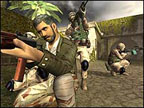
War Vets Feature in US Army Game
War Vets Feature in US Army Game by Alfred Hermida, Technology editor, BBC News website: The US military is putting soldiers who fought in Iraq and Afghanistan into its video game in an attempt to put a human face on its operations overseas. The soldiers' stories are part of a new version of America's Army, a game which is part of its recruitment strategy.
The US military denies that the project is a way of selling an unpopular war to the American public. Instead the free game is designed to inspire young people by relating the real-life experiences of the troops. "The majority of the public is not touched by the war," said Major Jason Amerine, who served in Afghanistan and is one of the nine soldiers appearing in the game. "It is dangerous to have an army overseas fighting and for a public to become so disconnected that they don't realise that we are not automatons over there. We're real people," he told the BBC News website.
'Real heroes'
America's Army was first released in July 2002 and has gone on to become one of the top online games, with seven million registered players.
It taps into the popularity of military and war simulation titles among predominantly young men.
It shows we are not robots, that we're not trained killing machines. We're just people.
It was developed by the Army to simulate combat and life in the military and reach young people for whom video games are a part of everyday life.
In the latest version of the game, called America's Army: Special Forces (Overmatch), the military is adding the experiences of nine soldiers who served in Afghanistan or Iraq.
The title has a so-called real heroes section when players can learn about the real-life troops.
In a virtual recruiting room, gamers can click on a soldier to hear them tell their story. They can also compare their achievements in the game to those of the GIs.
"It gets our stories out there about what the army is doing," said Sergeant Matt Zedwick, who served and was wounded during a tour of duty in Iraq in 2004.
"It is a good communications device to introduce people to what is really going on, rather than what you see on the news."
"It shows we are not robots, that we're not trained killing machines. We're just people," said the 25-year-old who is now studying graphic design at a college in Oregon.
Reaching the public
The US military sees America's Army as an information, rather than as a recruitment, tool.
The latest version was showcased at last week's E3 games expo in Los Angeles and is due to be released in the summer.
It comes at a time of growing unease in the US about the war in Iraq.
And last year, an official US government study warned that the military was falling behind in its effort to recruit troops for combat operations in Iraq and Afghanistan.
But the people involved in the title say there is no connection between the new game and America's troubles over its combat operations.
"We're not talking about the war, we're talking about people in the war," insisted Major Amerine, who served in Afghanistan in 2001 during the initial invasion.
"We are not attempting in any way to sell a war to the people, that has nothing to do with our agenda.
"We're trying to create awareness about the people doing the fighting, and that is a very apolitical agenda," said the major who now teaches at West Point.
Toy soldiers
As part of "real heroes" campaign, figures of the soldiers featured in the game are to go on sale.
The Army says these are not designed to be toys for children but items for collectors who wish to express their support for the troops.
Seeing themselves as little plastic soldiers is a strange experience for the troops involved.
"It is kinda funny and a little creepy. Unbelievable in a way," said Sergeant Zedwick.
"It is kind of funny to think there are going to be millions of people buying little dolls of you in the stores." [posted by Ryan Griffis on Rhizome Raw]
Posted by jo at 07:30 AM | Comments (0)
May 10, 2006
Blind Love
Extensions via Virtual World of Art
In Blind Love (click on Art), two visitors must find each other before they can find the way out of a pitch-black labyrinth. Each is armed with a weapon that shoots luminous particles. The particles explode on the walls and cascade into the corners, revealing the skeletal outline of the labyrinth's architecture. The two visitors must use the light emitted by their weapons to find one another, but-in an inversion of normal game logic-must not hit and kill each other if they hope to win. Like lovers, the visitors must blindly trust each other in order to survive, and must approach one another despite the danger.
Blind Love is one of the art works created for EXTENSION (click on Virtual World of Art, Extensions/SAT), a virtual architectural intervention that explores the potential of digital architecture to reveal and transform urban, cultural, and spatial identities. EXTENSION was created for the SAT in Montreal, one of North America's leading centres for new media. Visitors entering EXTENSION through the SAT terminals find themselves in a virtual space that mirrors their actual physical surroundings.

As they move through the environment, they cross from reality into virtuality, and from simulation into representation. Within the virtual environment, the existing building of the SAT has been recreated as a realistic 3D model. This simulation is transformed and reconfigured with the addition of a vast, zeppelin-shaped structure affixed to the roof. From inside this glass-encased space, visitors have a panoramic view of a virtual Montreal, where the city itself has been reconstructed with a poetic blend of realism and utopian fiction. Visitors to this near-real space discover experimental artworks in the halls and rooms of the virtual environment, and layered in other dimensions accessible through portals that brings the viewer into dedicated art installations. Anchoring virtual experience in real space, EXTENSION blurs the boundaries between imagination and perception. Grounded in the real but not limited to the realistic, EXTENSION is a reflection of the concepts and visions each of us forms about spaces and places.
EXTENSION is one of three nodes of the Virtual World of Art.

As technologically mediated experiences the Internet, games, cinema, television occupy ever more of our time and energy, it becomes increasingly vital that we create alternative spaces and environments for experience within these borderless territories of information and communication. Virtual World of Art invokes, manipulates and transforms the vocabulary and logic of game culture to create artistic engaging spaces which awaken aesthetic, emotional, social and intellectual responses radically different from those engendered by contemporary mass media. The project explores a variety of significant problems that cultural institutions committed to artistic practice within a networked electronic environment continue to face: how to create esthetically compelling and emotional online experiences, how to link physical and data spaces together, and how to effectively enable human communication and exchange in a physical space where local and remote visitors and performers can communicate virtually through technologies and computer interfaces.
Virtual World of Art investigates the artistic possibilities of immersive game technology and proposes new models for experiencing architectural and public spaces, sociability, and cultural production. Grounded in reality but not limited to realism, Virtual World of Art forms a dynamic, socially relevant, independent alternative to the existing art world, enabling artist to emancipate and develop a critical view of the future and meaning of contemporary art.
Virtual World of Art is the title for a series of new media art projects which subvert and reconfigure multi player game technology to create a network of artistic virtual environments. Each of these virtual environments called nodes, containing digital artworks and virtual art installations, is associated both conceptually and thematically with a specific site, arts centre or a public event where the project is presented on a long-term basis. These virtual environments are connected together by the internet forming a new kind of enlarged social and experiential public space for artistic expression and social exchange.
VWA will connect at least 3 locations or nodes in order to function as a complete project. Each node explores a different notion of hybrid between physical and virtual public space. Visitors will be able to interact through terminals installed at the nodes or at any public space in the world that has a high-speed internet connection.
Virtual World of Art is a project of Workspace Unlimited.
Posted by jo at 10:57 AM | Comments (0)
May 08, 2006
unexceptional.net
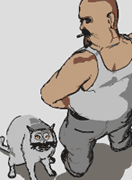
a multimodal,
-pervasive, location-aware, net-centric game
unexceptional.net is the gateway to Robert Nideffer’s mobile game that uses blogging, a GPS-enabled mobile phone, and a 3d game client in a game quest to find spiritual enlightenment, seriously.
Nideffer borrows from comics, graphic novels and computer games. The central character "Guy" has recently found out that his partner is having an affair. This discovery launches him upon a series of quests that you participate in, in effort to help Guy gain insight into the nature of his partner's relationship. The ultimate goal is to help Guy attain "enlightenment." To do this you must find key objects that open Guy’s seven major "Chakras," the energetic centers of the body according to Buddhist doctrine.
The project involves an extensive database infrastructure for storing and delivering game-state data via the Web, GPS enabled mobile phones, and a 3D game client. The Blog provides players information about what’s going on in Guy’s life, current game state, player locations, and quest progress. The Blog also provides an administrative framework enabling game designers to alter the game and have it immediately reflected in the various game clients. Players can also quest via voice. This has been done by integrating telephony software that incorporates automated call routing enabling players to receive calls based on where they are in physical space, as well as who they are in proximity to. Additionally, database and player interactions can be viewed in a Flash-based "Transaction Visualizer."
All data used in the game is location specific and sent to the phone and 3D client from the game server during game-play. Thus the game world is representative of the physical environment it's played in. This makes the game world extremely extensible while allowing for quests to be linked to specific locales. Game state is continually fed to the server via the different client interfaces, and broadcast back out to those interfaces. What happens in each of the interfaces effects the others in real-time.
A goal of unexeceptional.net is to push at the boundaries of network interoperability using a combination of freely available and custom-built software, and make the results easily available to others for their own creative experimentation.
via ucsc danm
Posted by michelle at 10:03 PM | Comments (0)
March 09, 2006
Calderoids

Calder’s Mobiles Led to Shooting Stars
Makers of Pac-Mondrian developed a new game called Calderoids in which players have to dodge and destroy Alexander Calder’s kinetic mobiles in the triangular ship of Atari’s space shooter Asteroids.
Calderoids combines the relatavistic theories of Alexander Calder’s kinetic sculptures with the virtual dimensions of Atari’s arcade classic Asteroids. (…) After creating Pac-Mondrian, we were on a mission to create a videogame art mashup for Atari’s greatest selling arcade hit, the space shooter Asteroids. The first artist suggested whose work lent itself to the form of the game was Joan Miro, whose pen and ink ‘Constellation’ series resembled a field of asteroids. Ian Hooper declared Calder’s mobiles filled a far better formal fit, given their fanciful free flight. Creating the first body of sculptures that moved, Calder called his early sculptures ‘Constellations’ after Miro, and presaged their videogame destruction in ‘Vertical Constellation with Bomb’. Although Mondrian’s squares provided the initial inspiration, the biomorphic forms in Calder’s mobiles were directly influenced by his friend and sometime collaborator Joan Miro. Ian Hooper’s conception of Calderoids mirrors Calder’s own aesthetic merging of Mondrian & Miro in the mobiles. After consuming the brightly coloured squares of Pac-Mondrian, and contemplating Miro’s constellations, the motion and form of Calder’s mobiles led directly to shooting stars in Calderoids. [blogged by nicolas on pasta and vinegar]
Posted by jo at 12:06 PM | Comments (0)
March 06, 2006
Desert Bus

The Torrent
Desert bus is probably one of the best games ever. Unfortunately the game was never released, until now. 11 years after the planned release date Waxy is hosting a torrent for this mythical game. The game is part of a long-lost Penn and Teller videogame.
The goal of the game is pretty straightforward. You have to drive a Bus through the desert from Tucson, Arizona to Las Vegas. The hard part is that the whole trip is in real-time, so it takes 8 hours at least. And it gets even better: There is no scenery or even other cars on the road, just plain desert, for 8 hours. Oh, and your bus veers to the right just slightly, so it’s impossible to just tape down a button and go do something else. Rumor has it that if you make it to Vegas, you score one point.
Really, you have to try this one. So grab the torrent (810MB, it’s a collection of great games), install a free SEGA cd emulator, and you’re ready to go. Have a nice trip. I will give 10$ 25$ to the first person who beats the game, mail me. More info. [via Torrentfreak]
Posted by jo at 06:05 PM | Comments (0)
February 09, 2006
Epidemic Menace

Crossmedia/Space Gaming
Epidemic Menace is a pervasive crossmedia game. Crossmedia games focus on a wide variety of gaming devices including traditional media channels, game consoles as well as mobile and pervasive computing technology to allow for a broad variety of game experiences. The overall goal of the game is to prevent the virus from escaping the campus, to clear the campus from the virus instances, create an antivirus to save Prof. Ivy Miller and to find out what happened on the campus. The winner is the team that that leads the high score list.
The game consists of two competing teams and each team holds a minimum of 5 players. Each team receives at the beginning of the game: 5 smart phones (one for each player); 1 Palmpilot; 1 AR system; 5 special online accounts (one for each player). Players can change devices or play modes anytime and can play on their own if they wish but have clear advantages through collaboration.
Game Space: The game is played in a physical and a virtual game space and teams have to play in both spaces in order to extinguish the virus. The virtual game space will be a model of the physical game space and game appearance and game mechanics will be adapted in the physical and the virtual game space. For example, the virus appears differently in both spaces.
In the physical world the virus may appear as: Spatialized sound, 2D Map, based display of viruses in proximity, Overlaid 3D graphics on AR devices, And in the virtual world the virus may appear as: Sound, Animated 2D and 3D graphics.
Storyline: The Dean of the Schloss Birlinghoven medical research laboratory Prof. Dr. Wolfgang Mathiessen has been working on a epidemic prevention program called EEPA (European Epidemic Prevention Association) for years and is very close to a mayor breakthrough that would have revolutionized the virus simulation programmes used by medical institutes around the world when the most part of his work is stolen and copied by a villain. The villain uses his work to infect a defined area of the Schloss Birlinghoven complex, his motives and his approach are unknown. The situation escalates when one of the medical researchers Prof. Ivy Miller is infected by the virus and falls into a coma. The EEPA is informed and a small group of experts is send to Schloss Birlinghoven to take care of the situation. [via pasta and vinegar] Report about the Crossmedia Game Epidemic Menace by Jan Ohlenburg1, Irma Lindt1, and Uta Pankoke-Babatz1 [PDF]
Posted by jo at 11:28 AM | Comments (0)
December 05, 2005
SenToy
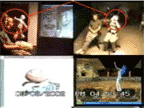
Tangibility in Gameplay
"ABSTRACT: In this paper, we describe a way of controlling the emotional states of a synthetic character in a game (FantasyA) through a tangible interface named SenToy. SenToy is a doll with sensors in the arms, legs and body, allowing the user to influence the emotions of her character in the game. The user performs gestures and movements with SenToy, which are picked up by the sensors and interpreted according to a scheme found through an intial Wizard of Oz study. Different gestures are used to express each of the following emotions: anger, fear, happiness, surprise, sadness and gloating. Depending on the expressed emotion, the synthetic character in FantasyA will, in turn, perform different actions. The evaluation of SenToy acting as the interface to the computer game FantasyA has shown that users were able to express most of the desired emotions to influence the synthetic characters, and that overall, players, especially children, really liked the doll as an interface." From Towards Tangibility in Gameplay: Building a Tangible Affective Interface for a Computer Game [pdf] by Ana Paiva, Rui Prada, Ricardo Chaves, Marco Vala, Adrian Bullock, Gerd Andersson, and Kristina Hook.
Posted by jo at 12:21 PM | Comments (0)
November 21, 2005
Sign of Hex168

Burning Man, meet E3
"I'm in the Mojave desert this weekend for the gamer festival that marks the launch of the XBox 360. Think: Burning Man meets E3.
While I'm playing GUN at 2 am in the desert with thousands of other gamers, you can watch me on MTV and MTV2 all week on A Gamer's Paradise, which is a special 1/2-hour show all about the Hex168 game that 42 Entertainment produced as a lead-up to the desert festival.
My role on the Hex168 project was to design an experience that would get hard-core videogamers out into the real world doing playful things with their friends. Over 2500 stunts across the U.S. later... well, you'll see: The show premieres tonight on MTV at midnight, again at 6:30 on Monday, and repeats 1o more times across the two networks throughout the week." [posted by Jane on Avant Game]
Posted by jo at 02:00 PM | Comments (0)
November 18, 2005
MuscleBody
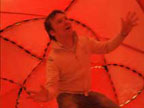
Translucent Skins
The MuscleBody is a full-scale prototype of an interior space. Its continuous skin incorporates all its architectural properties and makes no categorical distinctions such as floor, wall, ceiling, door. The interaction between the MuscleBody and its players (the people that have entered the interior space) causes the MuscleBody to change its shape, its degrees of transparency and the sound that it generates.
The structure of the MuscleBody is based on a spiralling tube that is bent in 3D. 26 industrial Festo muscles control the movement of the MuscleBody. The skin is made of Lycra, and its translucency depends on the degree of stretching. Speakers integrated into the skin generate sound samples that are combined and transformed according to the behaviour of the players.
The game starts when from the moment the visitor enters the MuscleBody. Information is abstracted from the behaviour of the players in real-time by pressure and proximity censors that are imbedded in the skin. The game-software VirTools organizes the relations between the input received by the sensors and the output consisting of the behaviour of the muscles and the generated sound. [blogged by Regine on we-make-money-not]
Posted by jo at 06:32 PM | Comments (0)
October 31, 2005
Project Entropia
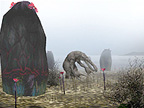
Gamer Buys Virtual Space Station
"A virtual space resort being built in the online role-playing game, Project Entropia, has been snapped up for $100,000 (£56,200). Jon Jacobs, aka Neverdie, won the auction for the as yet unnamed resort in the game, which lets thousands of players interact with each other. Entropia also allows gamers to buy and sell virtual items using real cash.
The space station is billed as a "pleasure paradise". Last year, a gamer bought an island for $26,500 (£13,700). The space station is described as a "monumental project" in the "treacherous, but mineral rich" Paradise V Asteroid Belt and comes with mining and hunting taxation rights. With the price tag also comes mall shopping booth and market stall owner deeds, a land management system, a billboard marketing system, and space station naming rights. Neverdie is a popular and well-known in-game character. He and another character, Island Girl, appeared in a 2003 dance music movie Hey DJ!, which starred Jon Jacobs, Charlotte Lewis, and Tina Leiu..." From Gamer buys virtual space station, BBC News. [Related]
Posted by jo at 11:01 AM | Comments (0)
September 21, 2005
Tale of Tales

Where Mouse Meets Forest
No longer solely for time-wasters, Massively Multiplayer Online Games (or MMOGs) are fast becoming the preferred method of conducting activities ranging from business meetings to weddings, to funerals. Trying to free these games from their often-violent plotlines are artists-designers Auriea Harvey and Michael Samyn, of Tale of Tales, a game design studio based in Gent, Belgium. Initial founders of the groundbreaking websites Entropy8 and Zuper!, the duo aim to challenge the fundamentals of game play by creating a 'plot free' experience of exploration and contemplation. 'Endless Forest' is their answer to this call. It's a third-person perspective 3D MMOG where each player assumes the likeness of a young deer running through a magical forest landscape. Harvey explains, 'We want to make paintings with game technology. Interactive, immersive, operatic paintings.' They conceived of 'Endless Forest' as 'a performance space and a screensaver, as an interactive environment masquerading as a game.' After releasing their first game, '8,' about a young girl-turned princess, the duo are attempting to use the medium as a storytelling device that replaces video gaming's traditional goal-based narratives with those of discovery and community involvement. The game is now in public beta-mode and freely downloadable at their website. - Jonah Brucker-Cohen, Net Art News, Rhizome.
Posted by jo at 07:23 AM | Comments (0)
September 19, 2005
Karma Physics< Elvis

Game Character Death
Karma Physics< Elvis, by Brody Condon, is a modification of the first person shooter computer game Unreal 2003. As the viewer camera floats through a pink afterlife, twitching multiples of Elvis are controlled by the original game's "Karma Physics" real-time physics system - generally used to simulate realistic game character death. Video.
Among Condon's work are also Waco Resurrection (blogged previously) and Suicide Solution, a DVD documentation collected over the last year of committing suicide in over 50 first and third person shooter games. Video. Some of his works will be part of Game Paused, a book, DVD, and exhibition to be held in London, Nov 3-13th. You can still submit your work. Participating artists include Roger Ibars, ////fur///, Julian Oliver, Cory Arcangel, etc.
Via Jonah Brucker-Cohen who's also made an interview of someone I like a lot on gizmodo. Roger is also showing works at My World, New Crafts, Experimenta Design 05, September 18th - October 30th 2005. [blogged by Regine on we-make-money-not]
Posted by jo at 08:46 AM | Comments (0)
September 01, 2005
Spot On:
Virtual Gaming's Elusive Exchange Rates
"MMORPG assets are being traded for real-world money. Are these virtual economies giving gamers their fair share?...
...While it may be hard today to arrive at accurate exchange rate data, many think this dynamic will change over time, mostly because the overall value of the market will one day be too big for real-world governments to ignore.
"Eventually, there's going to be a portfolio of these synthetic currencies," said Castronova. "Cyberspace nations that are issuing these currencies are going to be under legal obligation to report sales and volumes and transactions, because in worlds where those currencies can be freely liquidated into dollars, there are clear tax implications..." From Spot On: Virtual Gaming's Elusive Exchange Rates by By Daniel Terdiman, News.com.
Posted by jo at 12:14 PM | Comments (0)
August 07, 2005
Sim Civics
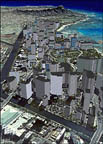
Public Participation in Regional Planning
Sim Civics by Jeff MacIntyre, The Boston Globe, August 7, 2005: New game-like computer software is empowering ordinary citizens to help design better cities. Can the professionals and the public learn to play well together?
[Image: SIM ISLAND--This 3-D image of Honolulu was created using GIS software from the company ERSI, as part of Honolulu's six-year planning initiative. (Courtesy of ESRI/City of Honolulu).]
"FIFTEEN YEARS AGO, the future of urban planning arrived in the form of a wonkish but strangely addictive new computer game. In SimCity, a player assumed the twin roles of mayor and city planner, creating elaborate cityscapes, managing zoning, transportation, and growth, while fighting off poverty, crime, traffic, and pollution..."SimCity...has probably introduced more people to urban planning than any book ever has."...Today, a new generation of GIS applications, known as ''scenario planning" or ''decision support" tools--which allow users to visualize, project, and manipulate a wealth of environmental data--have made citizens into major players in the gaming of urban futures. Across the United States...these tools are enabling an unprecedented level of public participation in broad regional planning initiatives..."
Posted by jo at 09:26 AM | Comments (0)
August 05, 2005
Day Of The Figurines

A Single Day in the City
Day Of The Figurines--by Blast Theory and partners--is set in a model of a fictional city that is littered, dark and underpinned with steady decay. From the Gasometer to Product Barn, the Canal to the Rat Research Institute, up to 100 players roam the streets, defining themselves through their interactions. A gunship of arabic troops appears on the High Street. Scandinavian metallists play a gig at the Locarno that goes horribly wrong. How players respond to these events and to each other creates and sustains a community during the course of a single day in the city.
In order to play the game you will need to visit the model at Blast Theory's Studio. From Saturday 30th July - Thursday 18th August we invite you to Blast Theory's Studio in London to register yourself and your phone.
Posted by jo at 10:46 AM | Comments (0)
July 04, 2005
Kick Ass Kung-Fu

An Embodied Gaming Experience
Kick Ass Kung-Fu is an immersive game installation that transforms computer gaming into a visual, physical performance like dance or sports. You can fight and defy gravity like kung-fu movie actors - only there's no wires or post-production needed, thanks to the real-time embodied interaction and virtual set technology.
The game takes place on a 5 meter cushioned playfield suitable for martial arts and acrobatics training. Using custom computer vision technology, you are taken inside an artificial reality where the normal laws of physics no longer apply. Your movements are exaggerated so that you can easily dodge your opponent's bullets by jumping five meters in the air and landing behind his back. Using the dual projected screens, one at each end of the playfield, you can also continue by counter-attacking your stupefied enemy from the behind. [via pasta and vinegar]
Posted by jo at 12:23 PM | Comments (0)
July 01, 2005
Games-Language

An interview with Noah Wardrip-Fruin
Noah Wardrip-Fruin is a digital media writer, artist, and scholar. His writing/art work creates new experiences of reading through bodily interaction, algorithmic recombination, and exploration of the potential of the network as more than a delivery mechanism. This work has been presented by galleries, arts festivals, scientific conferences, DVD magazines, and the Whitney and Guggenheim museums. As a scholar he has recently edited two books: The New Media Reader (2003, with Nick Montfort) and First Person: New Media as Story, Performance, and Game (2004, with Pat Harrigan), both from MIT Press. Wardrip-Fruin has taught writing for digital media in Brown University's Literary Arts program, New York University's Graduate Film and Television program, and the Summer Literary Seminars of Saint Petersburg, Russia.
His work is discussed in Information Arts (2002), Digital Art (2003), and Art of the Digital Age (forthcoming) - as well as in The Guardian, The New York Times, Technology Review, BBC News, Wired News, and U.S. public radio stories. Wardrip-Fruin grew up largely in California, in the cities of Palo Alto and Long Beach, though his family also spent time in Japan and Boston. He attended Long Beach Polytechnic High School, where his contemporaries included rapper Snoop Dogg, and graduated in 1990. After college, Wardrip-Fruin moved to New York City, where he was an artist in residence and then a research scientist at the New York University Center for Advanced Technology and Media Research Laboratory (1994-2001). At NYU he collaborated with computer graphics pioneer Ken Perlin on the design of next-generation interfaces and received an MA from NYU's Gallatin School, 2000. After NYU he became a professor at the University of Baltimore, where he collaborated with Stuart Moulthrop and Nancy Kaplan on the design of the curriculum for the newly-launched School of Information Arts and Technologies. From Baltimore he moved to Brown University, where he works with Robert Coover and others on exploring the literary potential of digital media (especially the immersive virtual reality "Cave"). He is currently a Teaching Fellow at Brown University, where this interview took place on April, 2005. We talked about Games, Language, Digital Literature and the Future of the Game theory.
Cicero Inacio da Silva* interviewed him.
Cicero Inacio da Silva: You have recently edited a book (First Person) on new media, story and games. Why are you interested in games?
Noah Wardrip-Fruin: For a couple reasons. I think that -- on a fundamental level -- playing games, performing for each other, and sharing stories and poems are deep human activities. All these activities have come to digital media, in one way or another, and I wanted to create a book where people who were thinking about all of these would be in one context, and could actually respond to each other -- so we can start to, through that dialog, think about the field in a broader way. This is part of the motivation. But another motivation was that, although I think this is changing, there was a sense that games were a kind of the Other, the separate thing in digital media. Games were very successful commercially, but very uninteresting from an artistic point of view, from a scholarly point of view. So I also wanted to challenge that a little bit and say: "Yes, games are one of the most popular forms of digital media, but they are also interesting art work, interesting writing, interesting design, and I think that scholars and artists have to contribute to our discussion about making and criticizing games."
CIS: What do you think about the relationship between games and literature?
NWF: There are three relationships that I want to think about. One is the relationship between games and the traditional literature. So, someone like Warren Motte, who has written a book called Playtexts (from the University of Nebraska Press), talks about writers, from the surrealists to the OULIPO, and many others groups, who used play as a way of thinking about their writing process, who used play as a way of thinking about the reading process that they wanted, how the audience can go through the text and engage with the text. That is one of the relationships that I want to think about. Another is that some early computer games were very textual, and some pieces were quite literary; others were graphical, and maybe literary in some structure, but not in the language that they contained. And what happened after that was that our ability to deal with language computationally didn't develop as quickly as our ability to deal with graphics. In the 1970’s and in the early 1980’s we tried to deal with language computationally using ruled-based artificial intelligence techniques, and that ruled-based artificial intelligence…
CIS: You mean an algorithmic process to produce a text or work…
NWF: Yes, right… I'm talking about processes for recognizing and producing natural language. At the moment we have techniques that work very well using statistical techniques, operating with large bodies of language. We use the patterns that we see in these large bodies of language to try to interpret and produce language, and that is more successful. In the 70’s and in the 80’s, we used ruled-based techniques, and we got some results, but could not go further. At the same time, computer graphics took off. Computer graphics driven by military applications, driven by Hollywood, and now driven by computer games, got better and better. So computer games, maybe for that reason, maybe for others, became more and more focused on graphics, and there wasn't much to say about that in terms of literature. Now, I think that is changing. Computer game companies are hiring full-time writers. They are hiring writers who have experience, who think and write through and for procedures. At the same time, our ability to deal with language, computationally and algorithmically, is getting better. So, the second issue to think about is how these things may be producing a new kind of literature, connected to the field of computer games. Now, most computer games are becoming better written, but often toward the goal of being like Hollywood blockbusters. However, I think there is a growing alternative game movement. And the alternative game movement may produce work as well written as good plays or good movies, instead of as the bad movies. The third interesting relationship is thinking about how literary structures may be important to games that it doesn't make sense to think of as literature. An example is quest structures. Espen Aarseth has written about this. Janet Murray has written about this. We don’t want to think about all computer games as literature, but we can better understand some of the structures by using literary models.
CIS: Actually, my third question has something to do with your answer… how do you see the game market with this explosion of these new game technologies, and with the big media companies (like Disney, Warner, etc.) getting inside this field?
NWF: Well, in the US we had our first big boom in games in the early 1980’s, and people like Warner did get involved; they did things like buy game companies. And this was huge in the US, because people were playing so many games… and then came the big bust. The computer game industry entered in a kind of collapse. Some people have interpreted that collapse, in part, as having to do with the intrusion of the big media companies. This leads to people saying: “Big media companies don’t understand games,” and so on. I don’t know if I believe that. It's hard to believe that big media companies categorically can’t understand games. But it is true that, right now, the big games companies are people like Electronic Arts, and people like Microsoft, although also people like Sony, and Sony does have a significant presence in other kinds of media. It'll be interesting to see how these big companies play out. All that said, I think right now most computer games are produced on the model of big media, where we have a big studio that spends a lot of money and takes a big risk trying to create blockbusters hits. And everything that is not a blockbuster hit is a kind of failure. We need to change that. I think computer games are only going to grow as an art form when they become much more diverse that they are now, in terms of their models of production.
CIS: Do you think that this “games invasion” is a fashion, or up-to-date, like the TV in the 50’s and the internet in the 90’s?
NWF: Well, I think TV in the 50’s and the Internet in the 90’s were marked by a struggle to understand something, and this is a struggle, probably momentary…
CIS: Let me situate my question: I think that the internet changed many points about our culture, and I think that, even today, we still cannot understand exactly what happen through the internet and on the internet. Now we have this game culture, which also uses the internet. Today, we still are thinking about what is the Internet, what kind of impact it has in our representations. I think that it is a great impact, it is something important…
NWF: Right. I am thinking that my mother has a laptop that she carries with her, not just when she travels, but she carries it around the house, you know…
CIS: My parents do the same...
NWF: Right. And when she is thinking about something, and she wants information about it, she opens her laptop and she does a web search. And, usually, the information she wants is right there. I think we haven’t finished thinking about what that means for our culture. For one thing, I think a large group of people assume that the online world is going to be like a library, with a lot of information available for free. That is very powerful, because the most powerful thing is what people take for granted, and what they take for granted is that the internet is a library, and if you try to change the internet and stop the internet from being a library they are going to say: “What?” They know that the internet is a library, and we can only see how that developed in retrospect. In the 1990’s we were saying: “What is the internet going to be? Is it going to be like cable television?” Now we know that for people like my Mother the internet is like a library (and email). We don’t know yet about computer games. We don’t know what sort of dominant models will develop, or if they will be like the current dominant models, or how they will challenge our expectations. But, certainly, for those in their 30’s and younger, we have a group of people who expect games to be part of daily life: not set apart in the arcade, but played on a console with a television; or played on a computer where they also do their work; or played on a device that they can keep in their pocket, like a Game Boy. So I think that it is taken for granted that games no longer are separate, and that will be, maybe, one change that we will start to see.
CIS: Yes, it was interesting when I was playing a certain game and, inside the game, I found I could go to the bank. It impressed me that while I play I am able to go to the bank, check my balance account, or transfer money to someone. In some cases, you can go to the supermarket and do some shopping. Also, we start to see a lot of ads inside the games...
CIS: What do you think about the critic view on VR, related to aspects like “reality” and “virtual”? Do you think that, with the VR, we are trying to build a new cave for our lives, as Plato pointed out, or that we are trying to understand how we are what we are? Do you agree with the point of view that we are outside Plato’s cave, and now why come back? We are already out, and there is nothing interesting outside, so now what?
NWF: (laughs…) If I remember Plato's cave correctly, there were chains, and we could only see shadows. OK, this is not the literal cave, and not the literal chains, either. So one thing that interested me about a lot of theories of virtual reality was the assumption that we could use VR to reproduce normal spaces, and to create impossible spaces. But I think that computer games are the closest thing that we have to popular Virtual Reality, even if it’s not stereo display. People move through virtual spaces a lot. Most of these virtual spaces operate by the same physics, as much as possible, as our reality, or contain structures as much as possible like buildings in our reality. It’s much more popular to play a game like Counter Strike than it is to play a game like an abstract shooter, where you can move through impossible spaces.
CIS: Like Doom...
NWF: No, let me think of a good example… I'm trying to remember the names of a couple of games made by a guy called The Yak, where what you do is fly. You fly in an abstract vehicle through abstract spaces that are made up with shapes and colors. And some are beautiful spaces, the kind of spaces that I think a lot of early Virtual Reality theorists imagined. And, of course, you are playing a game, and you blow up these beautiful things, and it makes great sounds when you move through it. But this is not as popular as shooting things in much more normal spaces. However, that said, we don’t really know what will become popular for a certain generation. It could be that when people who are now in their 30’s are in their 50’s they will want these impossible spaces. Or could be that they will want more and more realism, they will want The Sims. The Sims is about our everyday life, but maybe they will want even more reality: the people acting more like real people, the economy acting more like the economy. Who knows? It’s very hard for me to predict.
CIS: The representational aspect of the games is one of the most important points to discuss in game theories, because it implies in what somebody can do in a game: kill, explode, be a terrorist etc. And in the games we need a purpose or objective to continue playing, that always include kill, buy, sell or explode. Do you think it is possible to produce a game in witch an objective doesn’t exist? If it’s possible, what kind of game will it be?
NWF: First, I need to say that in some games, like Tetris, you don’t blow up anything and you can’t win. There is no objective about winning; the objective is only about not losing for as long as possible. I think this is kind of interesting, because we tend to think that Americans always want to win. And Americans love Tetris, Space Invaders and a lot of such games. Of course, you can have a high score -- maybe having a high score it the closest to wining -- but you always lose, and you need to keep from losing as long as you can. But, yes, I think that there are going to be, and maybe already are, digital media experiences that share a lot of traits in common with games, but have different kinds of goals and different kinds of actions that you take. But I’d say that if you don’t have game kinds of goals, probably we should not call the experiences games anymore. Maybe we should call them another kind of digital entertainment. So for example, do you know projects called Dogz, Catz, and Babyz? People like Andrew Stern and Adam Frank have worked on these projects, where you have just a little pet that lives on your computer and...
CIS: You published something about this in your book, I think in one of the discussions about an article…
NWF: Yes, in one discussion. Andrew Stern is one of the respondents in the book, and he talked about those projects. They are a kind of project in which you can explore your of relationship with the character, and I guess, from our point of view now, they might seem a bit primitive. You know, the graphics were simple, the artificial intelligence was simple, and who can imagine what will happen when things like this go further? Similarly, there are projects where the creators really focus on things like the story. Andrew Stern collaborates with Michael Mateas (who also has a piece in the book) on a project called Facade. In this project what you do is: you go over to have drinks with some people who you introduced and who are now married, and their marriage falls apart during your visit, but it falls apart differently, depending how you interact. It falls apart horribly, almost no matter what; there isn’t a way to win, there isn’t a score, and you don’t have to have a high score, but people play them. It’s not been publicly released, but I've played it, and replayed it, and a number of people that I know, who have received copies of it, are playing, and playing again, and playing again. Not because they want to do better, but just because they want to understand the space of possible stories. In some ways, it is a kind of postmodern fiction, which makes you think that the story can happen this way, or can happen that way, with much left to chance, and where you play the part of “chance.”
CIS: The game theory is nowadays exploring new theoretical interfaces, and some of them are narrative and literature. Some scholars are producing a lot of texts explaining the resources and the advantages of using games in the educational and pedagogical field, pointing out that games are easy and closer to their reality than books are. Do you agree with this point of view? What do you think of the critics that say that this student will be a person that just reacts to some specific actions, and that he or she will actually not think about it, or even elaborate some new point of view about his or her own situation? Or in other words, quoting Lyotard: “this is the perfect world to capitalism”. We will have just action and reaction. What do you think about this? How can we differentiate when somebody is responsive to a situation or when he or she is really thinking about a problem, even playing a game?
NWF: Well, one thing that we might have to think about is where the graphics technology for games comes from. A lot of funding is from military sources, and their aim was to create flight simulators and battle simulators. The reason the military put a lot of money into developing things like flight simulators is not because they thought that books are bad, but because maybe there were things that you can learn from the simulation, but you can’t learn from the book, or that are very hard to learn from the book. For them, these flight simulators were not an alternative to giving someone a book about flying, but were an alternative to actually putting someone in a cockpit of an airplane, an alternative to real world action. I think, in some ways, that what we need to think about is the goal of games in education. And the goal of games in education probably should not have to be trying to teach things that we can learn from books, but to teach things that we can’t teach with a book. And to teach things like these we might be able to simulate things that we can do in the real world, or things that we can’t do at all. People try to do this, for example, using games like SimCity to teach kids about cities. But there we run into another problem: Sim City does not come from nowhere, it is based on a research by an MIT guy called Jay Forester. Forester did a lot of work trying to understand urban planning through simulation, but his cities were very distorted cities -- for example, his cities have no suburbs, so we have children…
CIS: I also think that he never saw a “favela” in Brazil…
NWF: Yes, and if you have children trying to learn how to understand cities, and trying to learn how to understand cities through a simulation, that simulation will be always authored by people, and will always encode some of the ideological assumptions of those people. Part of what we try to do in education is to help students to develop a critical view of what they read in books; not just learning information, but also learning to think about what is not there, what the author doesn't say. What we now need to consider, in thinking about children learning through simulation, is how to develop a critical view of what they learn from the simulation, how they can understand the rules that make the simulation operate, and what are the limits and the blind spots of these rules. How children can develop that is a very tricky question; if they don’t develop that, then they are just reacting, they are just doing that simulation in a way that we don’t like. And the answer, maybe, is the same that we had from written literature, where people, or part of the people, achieve a critical view of what they read, and then they learn to write, and they learn about the writing process, and how with the writing process all these things came out. Maybe children will have to learn to author simulations, before they will be able to understand the relations, limits, and ideological field of games, and are able to be critical about simulations.
CIS: What do you think about the images in the games, aesthetically speaking? I mean, in 90% of the games we have, more and more, an exact reproduction of what we call reality. In the Renaissance, we have the same thing, and now, after Walter Benjamin, after Susan Sontag, after all the critics of the metaphor and representation, we are producing again the same reproduction of reality. Why do you think that we are doing this, if the computer can create images without any relation, or need, to capture this named reality?
NWF: One of my favorite phrases from a game theorist named Eric Zimmerman (and he has a lot of pithy phrases) is: “Cinema Envy”. He says that a lot of the game industry is caught up in “Cinema Envy”, and in part because cinema is taken seriously as an art form. But a lot of it is just because they like films, and because games right now can’t reproduce the cinematic experience, and because cinema is seen as desirable, and because you can be lauded as a computer graphics researcher for producing something more realistic. I think there are a lot of forces that drive games to increased cinematic realism, and, at some point, that will exhaust itself. I think, at some point, you will be able to, in real time, in response to what the users have done, produce something that is not distinguishable from a videotape, as good as the quality that you can get from your television. We’ll probably have to go that far before non-realistic rendering really begins to take hold. Right now, there are occasional games like Viewtiful Joe, done in cartoon style, where the imagery is really trying to reflect the content of the game in a non-cinematic way. But, right now, almost all the work that is trying to reflect the content of the game visually is drawing from cinema. Games like Max Payne are trying to look like a noire movie. They are not trying to invent a new way of looking, that only will be possible with the computer. Having said that, I think that we need to remember that movies are starting to be influenced by computer games. Maybe there is a new aesthetic form emerging from that as well. All that said, personally my interest in games is not usually driven by what the game looks like, and I agree with those critics who say that, regarding most serious players of games, they are looking through the imagery to the play. Eventually, what the game looks like becomes only a way of understanding the way that the system works. Games have a meaning in terms of play, and not only in terms of what happens visually; most games are about accomplishing something in terms of rules and goals, and those are not visual. On the other hand, I'm reminded that Peter Molyneux’s game studio is working on a game called “The Movies”, and the result of play is to produce trailers and snippets for movies, so your game goal is actually a visual goal, and those visuals try to have a style, but again it is a style based on movies, so who knows…
CIS: Do you think it’s possible that in the future a “game critic” will write about a game in an analytical and critical (scholarly) sense? I’m asking this because I think that the majority of the critics of Game Theories and digital narratives doesn’t quote or sometimes even know authors or important discussions about literature and literary criticism, and we know that this field had produced a lot of discussions about narrative, form, meaning, representation, reality, and one of the most important: ideology. Do you agree with this point of view? I think that some points of Digital Literature, and the use of the name “literature” itself, sound to me sometimes just as an attempt to give more credibility to this “digital” field, and what I see is a few authors discussing criticism, related to these “digital” topics of writing.
NWF: I think that one useful thing to do is to look at something called the “Scandinavian School” of games scholarship. Part of the reason is that this Scandinavian School -- and I am talking about people like Markku Eskelinen, Espen Aarseth, and Jesper Juul -- so these people, many of them are deeply engaged with contemporary literary criticism. They are very aware, and a number have backgrounds as literary scholars, so they know the history of literary criticism. And yet the work that they are doing is seen by some literary scholars as very naive, because their work is often quite formalist, trying to talk about the formal characteristics of games, or how you understand the passage of time in a game, and so on. People say: “We have been through this phase in critical history”. But their point of view is: “No, we haven’t been through this. We have been through this in literature, we have been through it for films, but we have to go through it again for games”. Because games are fundamentally different. And only once we go trough this period of formalism can we begin to take that formalism apart and expose its limits, and talk about the blind spots of the earlier generation -- but there has to be a first generation. Some people disagree, and they may also come from a literary background. Let’s say the Georgia Tech group -- people like Janet Murray, Ian Bogost, Michael Mateas, and Jay Bolter -- who have significantly less interest in formalism than the group I associate with Scandinavia, though also work on projects with names like "game ontology." Henry Jenkins -- who doesn’t come from a literary background, but from a media studies background -- in the First Person book talks about the Scandinavian Vikings versus the North American Eagles. There's some perception of conflict, but also a humorous attitude toward it. And we shouldn't forget people like Gonzalo Frasca, Nick Montfort, Stuart Moulthrop, and others who can't be put in a camp (or the fact that Gonzalo's been both at ITU Copenhagen and Georgia Tech). I guess I would say that, personally, I find a lot of valuable work in both groups. I think neither group is ready to have games just talked about in terms of current literary theory. I think that both groups agree that we need to develop some new perspectives to understand that games are procedural and interactive. If we don’t understand those things, and just apply perspectives from literary studies, we will misunderstand this experience. But I think we'll make progress. And just the same way every major university has cinema scholarship, I have no doubt that we will not have any serious university without game scholarship.
CIS: …and now, a hard question: do you play games? What is your favorite?
NWF: (laughs…) Yes, I play games, and playing games is like reading: it takes a lot of time. I mean, you're never caught up, you always need to do more than you have done. I think that is one of the advantages that cinema scholars have over us. You know, they take two hours to watch a movie. And you take so many hours to play a game, and to interact in a complex novel. You can go and survey the work of a major director in a week -- and if you go through a series of works by a major game company it'll take many times that. Anyway, my first experiences with games were with things like the Infocom games, like Zork, and maybe earlier things like Hunt the Wumpus. Then, when I was in high school, I played a lot of Tetris, and we had a Nintendo game console. I'm also passable at arcade games like Ms. Pac-Man and Centipede and Pole Position. Right now, I would say I've gotten to the point that my favorite things are experimental. So I really enjoy things like Façade, though I also enjoy playing blockbusters like Fable. But in some level, it’s not the same; the people who are doing Fable have an obligation to their funders to create something that will appeal to a really wide audience. And things with such appeal, not meant for a narrow audience, don't grab me in the same way.
CIS: Thank you and I hope that you can come to Brazil as soon as possible to work with us in future projects, and maybe develop a scholarship in the game field.
*Cicero Inacio da Silva is a Visiting Scholar, Brown University (Spring Term 2005) with a Fellowship supported by the Foundation for the Coordination of Higher Education and Graduate Training (CAPES/MEC/Brazil). Assistant Professor, Catholic University of Sao Paulo.
Links:
Warren Motte: http://www.colorado.edu/FRIT/profiles/motte.html
OULIPO (Cent mille milliards de poèmes: http://x42.com/active/queneau.html e Raymond Queneau: http://www.queneau.net)
Espen Aarseth: http://www.hf.uib.no/hi/espen/
Janet Murray: http://www.lcc.gatech.edu/~murray/
Electronic Arts: http://www.ea.com/
The Sims: http://thesims.ea.com/index_flash.php
Tetris: http://www.neave.com/games/tetris/
Dogs, cats and babies: http://www.quvu.net/interactivestory.net/papers/stern_emotionartifacts1999.html
Facade: http://www.quvu.net/interactivestory.net/
SimCity: http://simcity.ea.com/
Viewtiful Joe: http://www.capcom.com/vj/
Max Payne: http://www.rockstargames.com/maxpayne/
The Movies: http://www.lionhead.com/themovies/index.html
Markku Eskelinen: http://www.dichtung-digital.com/2004/3-Eskelinen.htm
Hunt the Wumpus: http://www.wurb.com/if/game/442
Infocom games: http://infocom.elsewhere.org/
Zork: http://www.csd.uwo.ca/Infocom/zork1.html
Gonzalo Frasca: http://ludology.org/staticpages/index.php?page=20030129004146960
Jesper Juul: http://www.jesperjuul.net/
Ian Bogost: http://www.lcc.gatech.edu/~bogost/
Michael Mateas: http://www-2.cs.cmu.edu/~michaelm/
Henry Jenkins: http://web.mit.edu/21fms/www/faculty/henry3/
Peter Molyneux: http://pc.gamespy.com/pc/the-movies/513182p1.html?fromint=1
The Yak: http://www.llamasoft.co.uk/jeff.php
Posted by jo at 05:01 PM | Comments (0)
Dream Catcher
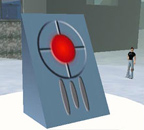
Do Avatars Dream?
Dream Catcher, by Milan Prucha, investigates the blurring of boundaries between 3D online games players and virtual life experiences.
The project is a dream recording and sharing service for Second Life avatars. The service can only be accessed by avatars (via specially designed dream recorders) from within the Second Life world. Although the work exists in a virtual and intangible space, the service itself (running live within Second Life) is real. Real people control the avatars, and hence the dreams that the service receives are the dreams of real people from all over the globe. [blogged by Regine on we-make-money-not]
Posted by jo at 08:24 AM | Comments (0)
June 15, 2005
Gaming Mind, Gaming Bodies:

Mind-Body Split For the New Millenium
"Abstract: The role of the body while playing a First-Person Shooter (FPS) may seem simplistic at first glance. We are sitting in front of the computer or TV and playing a game. However, the fact that we, as players, have another body within the game complicates this. Further complicating things is the fact that, like our bodies in the physical world, in a FPS we rarely see our virtual bodies. Therefore, the seemingly simple question of “Where is the body when we play a FPS?” in not one that can easily be answered. Unlike some types of videogames, such as older games like Pac-Man or Dig Dug, that only allow the player to move in specific directions such as up, down, left or right, in a FPS, the player, as in real life, is not confined to predetermined, limited set of movements but can turn, weave, walk in one direction while looking in another and so on.
Because the movements aim to replicate those of an able-bodied person, what happens while a person plays the game is that once the control system has been mastered, one tends to forget that they are controlling another body at all and become sutured into the world of the game. Essentially, when the game is going well, we as players have two bodies, one inside the game, and one outside.
Many scholars have argued that the dream of cyberspace is to leave the body behind and become pure thought. It is true that while playing a First-Person Shooter, the physical body is made absent. When I play one of these games, my own body is not what I am concentrating on. While playing I may physically sit in a chair, typically, I am not conscious of that sitting, nor am I aware of what my legs or feet are doing. This is why while playing a FPS, the physical body recedes away.
However, far from being a dream of disembodiment, FPS games are masculine embodiment writ large in which the entire point is the body. As depicted within the games, players are nearly always overly muscled, heavily armored men with hugely phallic weaponry. While it may be true that FPS games are all about the body, in a FPS, things are not as simple as they appear because the nature of a FPS, in which players see through the eyes of the body within the game, causes a further erasure to occur.
It seems that while playing a FPS game, not only is the player’s attention not dwelling on one’s embodiment, there seems to be another type of embodiment that is going ignored. Because players see though the eyes of the character, we do not see the that characters body and, for all intents and purposes, the player is the character. While it may seem that this is simply inserting the body into a virtual world, it does not do this at all. It creates a second body, which the action and pace of the game then serves to render invisible. At least for the experienced player, while the physical body is not the object of experience, neither is the virtual body. Thus, it seems that in a FPS, not only is a player not aware of one’s embodiment, they are similarly unaware of their disembodiment. In this way, it not only mirrors the invisibility of the physical body but also serves as a naturalization of that invisibility. The game causes us to forget about both bodies but still behave as if we were the hyper-masculine ideal. Thus, players are leaving behind the body, but taking the “meat” of the body with them. In this way, it seems that playing a First-Person Shooter is a way for society to further render the body invisible.
Drawing on Randy Martin’s Performance as Political Act and Drew Leder’s The Absent Body as tools to help understand both the disappearance of the body as well as the ways in which our body appears – or dys-appears, to use Leder’s terminology – when we stumble or are in physical pain, I argue that in some ways playing a First-Person Shooter is an attempt to gain a virtual form of embodiment in a type of body that society deems as the ultimate in masculinity. This attempt is less than successful, however, due to the very nature of the physical body in that it typically goes ignored unless something is wrong with it. In this way playing a First-Person Shooter causes the Cartesian mind/body split to be made literal with the mind in the physical world, a the body in the virtual world and a physical body that is nowhere to be found.
As noted, Drew Leder calls the negative appearance of the body that happens in situations such as when our bodies hurt or we trip a dys-appearance. Building on this, I call what occurs when a player becomes aware of their disembodiment as in a situation when a player’s fingers hit the wrong key or encounters a bug in a game, a dys-embodiment. These dys-embodiments call attention to the bodies of the game and the fact that while playing a FPS, the body within the game is not the same as the body outside of the game.
In this paper, I will show that questions such as, “What is the role of the body while playing videogames?” or “Where is the body located? Is it sitting in a chair in front of the monitor, or is it in the game running and shooting?” are not easy to answer. By problematizing our conception of the body and exploring the ways in which First-Person Shooters complicate notions of embodiment and disembodiment, I will show the form of the games themselves can have just as large a role in influencing our conception of self as the content of the games. “There is more than meets the eye” is not just a saying when it comes to First-Person Shooters." From Gaming Mind, Gaming Bodies: Mind-Body Split For the New Millenium (.doc) by Bryan-Mitchell Young, DiGRA Conference proceedings.
Posted by jo at 10:53 AM | Comments (0)
April 29, 2005
Computer Game Development Showcase

Game design and development at NCSU
"The Computer Game Development Showcase, the semester-ending presentation of student projects in the combined courses covering computer game development taught by the Computer Science Department and the Department of Industrial Design, has been scheduled for Wednesday, May 4, 2005 from 8:30 pm to 10:30 pm at Kamphoefner Auditorium on North Carolina State University's main campus in Raleigh." Showcase schedule of presentations.
"Projects to be shown during the showcase are the result of semester-long collaborative efforts between teams formed from students in Computer Science's course on Computer Game Design and Development and Industrial Design's 3D Realtime Modeling and Animation Studio. Each team will present a completed 3D game with custom artwork, 3D models, game play, character AI and interface design developed by the team members.
The event will begin at 8:30PM with a series of presentations by the project teams introducing their games. Following the presentations, all games will be accessible at PCs set up in the auditorium, providing attendees the opportunity to play the games and talk with the developers to learn more about the art and science that went into their construction. The event is free and open to the public."
Posted by at 07:31 PM | Comments (0)
April 19, 2005
Mogame + IPerG

Body and Game Controller
"One of the central features in the future will no doubt be networked play. Most traditional games are inherently social, and a mobile gaming device with network access provides opportunities for social gaming virtually anywhere, anytime. The possibilities for new game mechanics, taking advantage of the full range of contextual information provided by pervasive systems, expand the research and design space further. This is one of the major research directions being explored by some ongoing projects in the Tampere GameLab. This is also where new approaches to Huizinga's bounded 'magic circle' of game playing are tried out and investigated." From The City Shaman Dances With Virtual Wolves–Researching Pervasive Mobile Gaming by Frans Mäyrä, Receiver #12.
Posted by jo at 11:24 AM | Comments (0)
March 10, 2005
PlaceStorming: Performing New Technologies in Context

...Performative Aspects of Gaming
"ABSTRACT: We present PlaceStorming, an original method of brainstorming technological concepts, particularly in the area of pervasive computing. PlaceStorming is context-driven and play-based, combining real world environments with the immersive and performative aspects of gaming. In this paper, we discuss the background and techniques we used to create and deploy our method. Examples are drawn from a March 2004 PlaceStorming event to highlight key strengths of the method. Suggestions are made for what produces successful PlaceStorming sessions." From Place Storming: Performing New Technologies in Context by Ken Anderson, Intel Research, and Jane McGonigal, University of California at Berkeley. Proceedings for the 3rd annual Nordic Conference on Computer Human Interface (NordCHI 04)
The PlaceStorming project is a collaborative, pervasive play scenario that uses GPS data, mobile network technologies, and digital media devices to facilitate, as a public practice, context-aware and location-specific academic research. (Jane McGonigal is) developing it in conjunction with a Vectors fellowship from the University of Southern California. The technologies and media employed for v 2.0 are: text and Instant messaging; cell phones; handheld Global Positioning System devices; digital cameras; Web-accessible database.
Posted by jo at 05:23 PM | Comments (0)
January 12, 2005
ARQuake

Re-Locating Monsters
ARQuake is an Augmented Reality (AR) version of the popular Quake game. Augmented reality is the overlaying of computer generated information onto the real world. We use a head mounted display, mobile computer, head tracker, and GPS system to provide inputs to control the game. Using ARQuake, you can walk around in the real world and play Quake against virtual monsters...Our task at the moment is to take all the monsters and the guns etc. out of the quake game and to make them roam around a real environment. We also required the player of the game to move around the real world and have all the monsters appear as though they were standing next to and behind real buildings. Read ARQuake: An Outdoor/Indoor Augmented Reality First Person Application [PDF]; view videos.
Posted by jo at 11:07 AM | Comments (0)
December 27, 2004
netzwissenschaft
![]()
Emerging Infrastructures of All (Inter)net Research
Dr. Reinhold Grether's network research | netzwissenschaft site maps the "emerging infrastructures of all (inter)net research endeavours. net.science as an anthropology of connectivity is trying to overcome the constraints of specialist method transfers on net matters. the protuberance of technical networks necessitates a professionalization of human net knowledge. neither the isolation of concepts as in basic research nor the encapsulation of processes as in applied sciences will ever be able to adequately describe the complex autopoiesis of networks. net.science is undoubtedly developing into a scienza nuova of its own right."
Check out his Mobile Art and Virtual Performance research areas.
Posted by jo at 04:45 PM | Comments (0)
December 09, 2004
Are cell phones new media?

re-narrating cities via nomadic technologies
"Multiuser environments in cyberspace have frequently been regarded as utopian spaces in which users could project their imagination. When communities are shaped in a hybrid space, mobile phones become new media tools for creating novel and unpredictable imaginary spaces, re-narrating cities. Fixed Internet users do not have the ability to move through physical space. But the emergence of nomadic interfaces represents a chance for such imaginary spaces to be enacted and constructed in physical space.
Nomadic technologies have a twofold role in the construction of playful/narrative spaces. First, they allow virtual spaces to be mobile, bringing them into the physical world. Second, when used to play games, they free the game from the game board or the computer screen, making it possible to use the city space as the game domain." from Are cell phones new media? by Adriana de Souza e Silva [Related]
Posted by jo at 12:44 PM | Comments (0)
December 03, 2004
Grand Thieves Audio modologues

We're tired of stealing cars. So we're stealin' the soundtrack...
Grand Theft Auto: Vice City, an earth-shaking game of theft, prostitution, , and beautifully animated racist depictions of Cubans and Haitians. You are free-wheeling Tommy Vercetti, driving any car you can pop the lock on, taking s out to the lighthouse, enjoying all the pixilated pleasures the 80s can offer you. Bunk is making the game that much better because we're putting somebody in the car with you. We're carjacking the game with a mod of our own...This is only the beginning, the first in a series of monologues (or modologues) and performances we're testing out. Send us yours and we'll feature them on the page...(Modologue: Machinima-style dubbing that modifies game-play through an alternate narrative.)
"On Bunk, we've published the beta of the "Grand Thieves Audio" project. These MP3s constitute our attempt to carjack the audio on "GTA: Vice City." These audio files attempt to recontextualize the playing experience along subversive avenues. The idea is to create the illusion of new (subversive) nonplayer characters in the game through the audio."
These modologues combine the audio dubbing of machinima with the infiltration of game mods (since sticking them in your MP3 folder does not alter the code of the game). Unlike Machinima, which dub sound tracks over edited clips of game play and turn the player into a spectator, these monologues, or "modologues," let the user play in a different narrative context.
These files represent the first attempts to infiltrate the game. I hope other performers will record some and send them our way so we can build a library.
Current downloads include: Army Recruiter (since video games are now tools of recruitment), Mama Vercetti, The Driver's Ed Instructor, and Arnold Schwarzenegger (though this last is anachronistic and probably more suitable to "San Andreas")."
Posted by jo at 10:38 AM | Comments (0)
November 25, 2004
Suspended Disbelief
When "Majestic" was released by Electronic Arts in 2001, much intrigue was raised by its scope - this was a game that raised the level of interaction several notches by engaging players through unconventional methods such as voicemail, fax, and instant messaging.
Along comes the recent "I Love Bees" phenomenon, a detailed game that was essentially a lead-up to the release of Halo 2 for the Xbox platform. Released online as serial "episodes", the innovation of "I Love Bees" was the component in real space, where gamers used GPS coordinates to arrive at a telephone booth at an appointed time, and, if they were lucky, converse with a voice actor about the developing "I Love Bees" storyline.
Taking things one step further, "Regenesis" is a television show, but one that also allows participants to become more deeply involved. Registering on the show's website will enable you to access online video diaries and a password-protected website. The game's creators also use email dispatches and voice mail to deliver clues.
In film, the state of immersion where you are completely absorbed and temporarily ignore one's internal critical voice is called "suspension of disbelief". Console and online games are also absorbing and can transport players completely into new worlds. When games nibble at the edge of reality, invading traditional spaces of social interaction such as instant messaging and voice mail, the standards for creating a state of suspension of disbelief are raised to incredible proportions. (Posted by Michelle Kasprzak)
Posted by at 01:16 AM | Comments (0)
November 20, 2004
COCKFIGHT ARENA
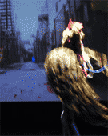
With Wings and Feathered Helmuts
Cockfight Arena (Eddo Stern with Mark Allen, Jessica Hutchins, Karen Lofgren): a one night parade of sweat and adrenaline hopes to reclaim performance art in the age of video games, pitting viewer against viewer in brutal virtual cockfighting theater. Audience volunteers suited up in custom-made wireless game controllers with full sized wings and feathered helmets. Combatants stepped into an arena to control their life size game avatars through vigorous flapping and pecking, competing for blood and birdfeed while rapaciously inflicting onscreen bodily harm in a custom made "joustlike" fighting game. [via]
Eddo Stern was born in Tel Aviv, Israel. His working interests are in structures of narrative and documentary, fantasies of history and technology, cross-cultural representation, and the phenomenological and cultural expanse of computer games. He works discriminately with a wide variety of media—computer games, electronic devices, software, video, sculpture and performance. His work has been shown internationally at new media and film festivals, museums, galleries, and game conventions. In 2000 he started «C-level,» a cooperative artist-run new media lab and art space in LA's Chinatown; currently lives near Los Angeles.
Source: http://www.medienkunstnetz.de/artist/stern/biography/, Florian Zeyfang, Interview with Eddo Stern, Tages Anzeiger, February 2002 and web at http://www.c-level.cc
Posted by jo at 09:53 AM | Comments (0)
November 19, 2004
Human Pacman

Seamlessly Connecting Between Real + Virtual Worlds
CNN reports on a Human Pacman game, developed by Singapore based researchers, that can be played out in the streets or any real environment. The system was designed by the Mixed Reality Lab at the National University of Singapore. It includes Bluetooth, GPS, head-mounted displays and inertia sensors. Pacman can pick up power pills (in the form of Bluetooth enabled boxes in the environment used in the game) in his attempt to avoid pursuers. Read more at the New Scientist. (via)
Human Pacman has several novel aspects: Firstly, the players immerse in role-playing of the characters, physically moving around in a wide-area setting and performing tasks to reach their goals. Utilizing the computing power of wearable computers and the underlying network support, Human Pacman players experience seamless connections between real and virtual worlds as immersive first-person augmented reality view and full virtual reality view of the fantasy version of the game, Pacworld.
Secondly, Human Pacman also explores novel tangible aspects of human physical movement, senses and perception, both on the player's environment and on the interaction with the digital world. For example to devour the virtual "enemy", the player has to tap on the real physical enemy's shoulder, which is an instinctive action to "catch" the "enemy."
Thirdly, users enjoy unrestricted movement outdoors and indoors while maintaining their social contacts with each other. Players interact both face-to-face with other players when in proximity (physically) or indirectly via the wireless local area network (LAN).
Posted by jo at 11:02 AM | Comments (0)
October 28, 2004
RE-PUBLIC

Drama, Mediation, Performance and Mobile Games
Intermedia at the University of Oslo has an interesting project about mobile gaming. RE-PUBLIC is a project that deals with humanistic perspectives on emerging digital communication forms & expressions & their information systems.
What are the dramaturgical and mediational features of commercial mobile games? Do location sensitive, always online, portable gaming terminals change the dramaturgical and mediational features of commercial mobile games? How will such terminals interact with ubiquitous computing in the physical environment to create new forms for hybrid games? How and to what extent are the less pre-scripted qualities of mobile and context-related play realised textually and interpersonally? How can the humanities inform and perform ICTs and vice versa? What can the study of computer games tell us about performance and the obverse? How can performance influence the design of computer games? What kinds of performances emerge in multi-player role-playing games?
Originally from pasta and vinegar, reBlogged on Clippings on October 27, 2004
Posted by jo at 09:29 AM | Comments (0)
October 15, 2004
City of Heroes
Virtual Memorial
"City of Heroes players memorialize Christopher Reeve: Memorial vigil held by players of the online superhero MMORPG honors passing of the Man of Steel"; by Tim Surette--GameSpot; POSTED: 10/12/04 02:01 PM PST
After the news of the passing of Christopher Reeve hit the airwaves, players of the massively multiplayer online role-playing game City of Heroes gathered together for a memorial for the fallen hero. Players gathered in full hero garb and saluted in tandem in memory of the man best known for playing Superman on the big screen. Reeve, who became a champion of spinal cord research following a paralyzing horse riding accident in 1995, died Monday as a result of heart failure stemming from an infection related to his paralysis. He was 52 years old.
Posted by jo at 12:47 PM | Comments (0)
September 29, 2004
AVATARA
![]()
Troubling Utopia
From Edward Picot's review of AVATARA's DVD\"Machinima Documentary" by Donato Mancini, Jeremy Turner and Flick Harrison (536 Productions).
Avatara, from a Canadian team called 536, is a documentary about an online community - "a global subculture who spend their lives immersed in an online 3-D voice-chat program", as the blurb explains. What makes this particular documentary special is that "every second... was recorded in-world (ie. online, within the virtual environment), so we don't meet the people directly. Instead, their voices speak to us through the puppet-like 'avatars': rabbits, pharaos, seahorses, giraffes, the grim reaper, flowers, guitars, trolls (etc) which they've chosen to represent themselves in cyberspace." Because of this immersive approach the documentary is more than just a factual report about these people and their private activities: it gives us a sense of what their world feels like from the inside.
Posted by jo at 04:20 PM | Comments (1)
September 26, 2004
(T)ERROR
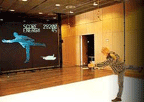
Full Body Engagement
Whom would you like to play to get the world back into right shape? George W. Bush, Osama Bin Laden, or rather Tony Blair? Starting the computer game (T)ERROR, the player is spoilt for choice. A camera tracks the player’s movements and a projector throws the players outlines in original size on a white wall in front of him, all in realtime. When the player kicks, his shadow will kick. When the player ducks or jumps to avoid bumping into an enemy jet, his shadowy avatar will do exactly the same in real time. Watch videos.
Posted by jo at 03:20 PM | Comments (0)
August 16, 2004
mobile games

Mobile Hunt
-- the "ultimate scavenger hunt game engine"
Undercover
-- "The World is a Mess. GET TO WORK. Terrorism has become a critical and largely unknown enemy. Lunatics are making the world an unsafe place. It's past the time to stop it. This is our mission and, if you join us, your duty."
Two in a list of Location-Based Mobile Games found by Mjriam Struppeck from www.interactionfield.de
Posted by newradio at 11:35 AM | Comments (0)
August 01, 2004
O.U.T. There
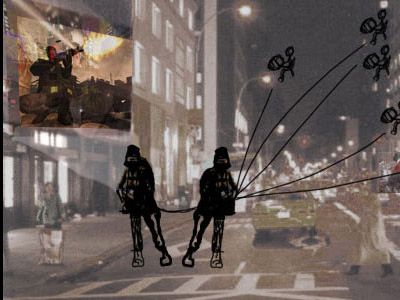
Two women in gear are on the ground. One with a laptop and the other with a projector pointing onto building walls in 3 key locations in the city. They are connected through a mobile wireless bicycle to an online team of five game players located around the world. They intervene on servers in a popular online military simulation game with performance actions carried out by the whole team. The live projections in the city can also be viewed through a web cam on the OUT website.
OUT takes its name from MOUT a military term for Military Operations in Urban Terrain. Many military simulation computer games implement MOUT. For example, the US Army developed game Full Spectrum Warrior trains gamers in MOUT combat. OUT is a criticism of the increasing militarization of civilian life which has been implemented in the US and elsewhere since 911. The Patriot Act, surveillance of public libraries, and the increased powers of government to hold citizens in military custody without trial are instances of these increased powers of government instigated by the Bush administration. In an endless spiral war of terror a government is at war with its own citizens, with soldiers in the midst of the fabric of ordinary life, as has been the case for a while in terror alert cities like Tel Aviv and Jerusalem.
OUT is an artistic intervention in the public space of online games and cities. OUT is also happening at a moment when the street has become again a viable mode of expression. From Seattle to Cancun activists are using wireless technologies and the web to organize actions and and congregate. Dada-like agenda-less mobs have appeared in New York and spread to other cities, In contrast, police at these events are increasingly high tech and cyborgean. They wear the latest riot gear shields and padding and use high tech wireless communication systems. They move in sophisticated crowd control formations. OUT, on the other hand, is a high tech art intervention, art activists with high tech gear and strategy. OUT of the closet of MOUT.
Republicans OUT of New York. The United States OUT of Iraq and the Middle East. Escalating worldwide Militarism and Violence, from whatever source, (right wing oil hungry U.S. capitalists or wealthy Islamic fundamentalists), OUT of Civilian Life. The U.S. Army and Pentagon computer game developers OUT of the minds of prebuscent gamers.
Posted by michelle at 03:45 PM | Comments (0)
July 27, 2004
More about Blast Theory
 Matt Adams of Blast Theory posted a comment of encouragement to the blog's opening and I'd like to follow up with more about Blast Theory and a call out to Matt to respond to some specific questions about their work.
Matt Adams of Blast Theory posted a comment of encouragement to the blog's opening and I'd like to follow up with more about Blast Theory and a call out to Matt to respond to some specific questions about their work.
Blast Theory, comprised of Matt Adams, Ju Row Farr, and Nichols Tandavanitj, describe themselves as 'an artist group whose work explores interactivity and the relationship between real and virtual space with a particular focus on the social and political aspects of technology. It confronts a media saturated world in which popular culture rules, using video, computers, performance, installation, mobile and online technologies to ask questions about the ideologies present in the information that envelops us.'
This is evident in a survey of their work over the past decade. Formed in 1991, a chronology of their work from 1994-2004 is available on their website where the themes and explorations of technology range from video in live performance to interactive installations with the most recent using a pda or 3G phone to enable a mixed-reality game-based experience.
Beginning with their 1999 work Desert Rain and continuing on to the mixed reality works Can You see Me Now (project website), Uncle Roy All Around You (project website), and I Like Frank (project website) they have collaborated with the Mixed Reality Lab (MRL), an interdisciplinary research initiative at the University of Nottingham which brings together leading researchers in Computer Science, Engineering and Psychology to research new technologies that merge the physical and digital worlds, focusing on playful, artistic and educational applications.
The projects with MRL are clearly interactive in their game structures and use of mobile, networked technologies. The hybrid online/live action approach was explored in Kidnapped (1998) and interactivity has been a component in the early work since Stampede, (1994) in which the audience triggered how the piece unfolded via pressure pads.
Their work has been described as 'somewhere between theatre, performance art, installation and club culture' by Lois Keidan, Director of Live Arts, Institute of Contemporary Arts, London. In reviews of Uncle Roy in 2003 a direct link to the content and approach of their work can be found - a group of friends with various creative backgrounds get together to form a theater company. This comes through in Matt's initial comment to the blog in which he claims his excitement for recent developments in networked_performance, despite the backward looking stance of many traditionally moored theater and dance practitioners. Blast Theory is freed from any prior history in a single discipline by having a group comprised from various practices across which they draw to create their work.
Some Questions
Matt, firstly, correct any inaccuracies in the above. Would you tell us what are the backgrounds of the members and elaborate on the evolution of the group from the early years till now. What led to the formation of the group and why theater? It seems that BT has always had an interest in media and technology born of club culture perhaps. What is the importance of the 'live' and 'performance' aspects of your work? As opposed to addressing the same social and political themes about technolgical impact on culture by focusing solely on interactive installations, such as in An Explicit Volume, for example.
How did the collaboration with Steve Benford and MRL evolve? How has the relationship with MRL influenced BT's work conceptually? You might also elaborate on how the collaboration has enabled your work to evolve technologically as well. Can you speak about the offshoot of the BT / MLR collaborative endeavor, EVERPRESENCE and your project Vicinity to which you've been able to apply these joint efforts? It appears to include aspects of the mixed reality game-based works and a reality-tv episodic, perhaps. What's the timeline for presenting this work?
You also mentioned in your post that there is lots of interesting work happening in networked_performance. What's out there that you currently find interesting and why?...
Posted by michelle at 08:13 PM | Comments (3)


